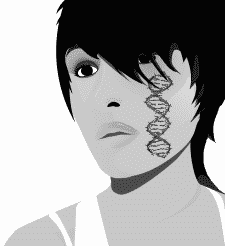Familial Hemiplegic Migraine - Types
Current research is giving us new understanding of familial hemiplegic migraine (FHM) and how various subtypes may have different symptoms and require different treatment. The information about these types of migraine is still very new, and these types of migraine are very rare. However, a lot of research is being focused on this area, because an understanding of how this type of migraine works may give us insight into other types as well.
For specific information on diagnosis and treatment, read this overview of familial hemiplegic migraine. In this article we'll take a look at the different sub-types of FHM.
Genetic clues
Researchers use genetic clues to differentiate between different types of familial hemiplegic migraine. They want to know, for example, what difference a certain genetic mutation makes. Is a patient with one type of mutation more likely to have certain symptoms? Is one type of treatment more likely to work with these patients? If we can answer questions like these, we will be able to find better treatment faster. Today we are only beginning to find answers - there's a long way to go.
This type of migraine is called "familial" because of the way it is diagnosed. If you have a close relative with the same condition, you're given a diagnosis of FHM. Otherwise it's called sporadic hemiplegic migraine.
Though the genetic markers are more likely to be found in FHM, they can also be found in patients with sporadic hemiplegic migraine. Not all patients with FHM have genetic markers - that is, that we know of. There is much more to discover in the years ahead!
Types of Familial Hemiplegic Migraine
There are three genes known to be associated with FHM. Let's take a brief look at the the subtypes of FHM:
- Familial Hemiplegic Migraine 1 (FHM1): About 7% of patients with FHM seem to have FHM1. FHM is related to the gene locus CACNA1A. This gene is related to other conditions, such as nystagmus (involuntary movement of the eyeballs) and ataxia (unsteadiness, loss of muscle coordination), as well as same cases of more common types of migraine. Ataxia is a very common symptom of hemiplegic migraine. About 40-50% of families with FHM1 experience nystagmus and ataxia (chronic and progressive, though usually mild). Fever, confusion, and loss of consciousness may be more common in this type of migraine, sometimes even including coma.
- Familial Hemiplegic Migraine 2 (FHM2): Another 7% of FHM patients have FHM2, characterized by a gene mutation in ATP1A2. This gene has been connected to seizures, fever, and other mental illness, as well as at least two other types of migraine. This type of FHM often occurs with epilepsy.
- Familial Hemiplegic Migraine 3 (FHM3): Characterized by mutations in the gene SCN1A, this type of migraine is believed to be extremely rare. Seizure disorders have also been connected to this gene mutation.
The term FHM4 has already been used related to research done by Gardner et al in
A new locus for hemiplegic migraine maps to chromosome 1q31 from the Neurology journal, 1997. There's little doubt that much more will be discovered that will improve our understanding not only of hemiplegic migraine but all types.
It was once thought that FHM1 accounted for about 50% of all cases. It's true that other types are rarely mentioned in medical literature. However, a study from Denmark in 2007 suggested much lower numbers, hence the change.
Particularly with FHM1, though in reality with all types of hemiplegic migraine, the attacks can be confused with
basilar-type migraine. It's the muscular weakness that differentiates between the two. It's possible that there's a genetic link as well between FHM2 and basilar-type migraine.
Looking ahead
One more thing we should note. These are complex genetic relationships that we're only beginning to understand. For example, it's not just one simple mutation of one gene that causes FHM1 and other conditions such as ataxia or nystagmus. Already in this one gene, dozens of different mutations have been associated with FHM1 alone, and these interact with various other factors in an individual (genetic and non-genetic) to bring about a specific condition or symptom. This is why the research is taking time and isn't a matter of putting together a simple 500 piece puzzle.
As we learn more about these genetic markers, we can see the connection to other disorders. It is hoped that new and better treatments will be developed as we learn to understand just what migraine is. In fact, some of these same genetic markers have been found in people with more common types of migraine, and knowing this gives us more reason to study these clues.
In fact, our study of familial hemiplegic migraine has already helped us better understand possible reasons for migraine gender differences, and the use of treatment based on the body's calcium channels and sodium channels.
For more indepth information about the genetic side of FHM, read Familial Hemiplegic Migraine by Dr Joanna C Jen.
Further references: Ion Channel Diseases edited by Guy Rouleau and Claudia Gaspar, December 2008; The International Classification of Headache Disorders 2nd Edition, International Headache Society, 2003
Enjoy this page? Please pay it forward. Here's how...
Would you prefer to share this page with others by linking to it?
- Click on the HTML link code below.
- Copy and paste it, adding a note of your own, into your blog, a Web page, forums, a blog comment,
your Facebook account, or anywhere that someone would find this page valuable.
